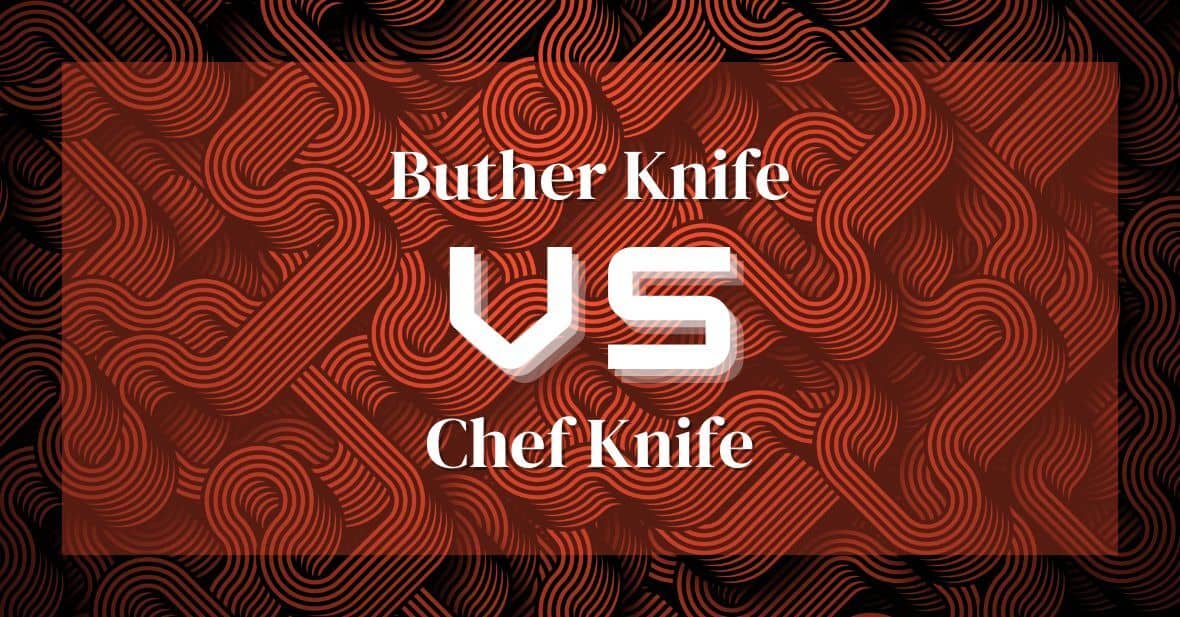Butcher Knife vs Chef Knife: The Cutting-Edge Clash
When it comes to the kitchen, there’s nothing more important than having the right tools for the job. And when it comes to knives, no two are as different as a butcher knife and a chef’s knife.
It’s like night and day – or should we say steak and cake? These two knives have unique designs that make them perfect for their respective tasks. But how do you know which one is right for you?
In this article, we’ll compare these two blades side by side to help you decide! So grab your sharpening stone and let’s get started!
Blade Length
You’ll notice that the blade length of these two blades differ, with one being slightly longer than the other. The butcher knife is typically around 8-10 inches long, while a chef’s knife is usually between 8 and 12 inches.
This difference in size can make a big impact on how you use them. For instance, if you’re looking for more edge retention when cutting through tough meats or vegetables, then the longer blade of the chef’s knife will be better suited for your needs. On the other hand, if you’re looking for more grip comfort when slicing and dicing smaller items like herbs or garlic cloves, then the shorter blade of the butcher knife may be preferable.
Ultimately, it comes down to personal preference and what type of tasks you plan to do with each type of knife.
Blade Shape
With its wide, curved blade, the chef’s knife offers a cutting advantage compared to other options. Whether you’re prepping for a dinner party or slicing through thick cuts of meat, the edge sharpness and weight balance of this particular knife can make a world of difference.
For starters, the shape makes it easier to rock the blade forward and backward when slicing something like an onion instead of having to use a sawing motion with lesser quality knives. Additionally, its curved edge allows for increased leverage when you need that extra bit of power while dealing with tougher ingredients such as meats and hard vegetables.
Finally, since it’s lightweight and well-balanced in your hand, there is less strain on your arm. This makes it ideal if you’re preparing large quantities for extended periods of time.
Blade Thickness
Gain an even greater advantage with a chef’s knife by opting for one with a thicker blade; it will help you slice through larger and tougher ingredients effortlessly. A thicker blade is more durable, less prone to breaking, won’t bend as easily when applying pressure, and provides better leverage when chopping. Plus, it can handle tougher tasks like cutting tough meats and bones. To get the most out of your knife, consider the type of steel used in its construction – some steels are not suitable for making knives with thick blades because they are too soft or brittle. The hardness of the steel is also important; harder steels have better edge retention but may be harder to sharpen.
| Steel Type | Hardness (HRC) | Pros/Cons |
|---|---|---|
| Carbon Steel | 55-65 HRC | Sharp & holds edge well; rusts easily |
| Stainless Steel | 56-62 HRC | Resists corrosion; difficult to sharpen |
| High Carbon Stainless Steel | 58-60 HRC | Combines benefits of both carbon & stainless steel; susceptible to rust if not cared for properly |
Handle Design
The handle of your kitchen knife is just as important as the blade, so make sure you pick one that fits your hand like a glove — after all, a bad workman always blames his tools!
A butcher knife and chef knife both have unique handle designs for their intended uses. Butcher knives are often more chunky with an ergonomic design that allows you to get a good grip for heavy-duty cutting tasks. On the other hand, chef knives usually have a thinner handle to provide better maneuverability when slicing and dicing.
When considering the handle design of your kitchen knife, take into account storage solutions and maintenance tips. A well-made handle should be easy to keep clean and store in drawers or on magnetic strips. Additionally, look for handles made from materials such as wood or stainless steel that offer great durability and won’t become slippery during use.
With these three key points in mind, you can find a kitchen knife with the perfect handle design!
Intended Use
Decide what tasks you plan to use your kitchen knife for, so you can choose the right tool for the job.
Choosing between a butcher knife and a chef’s knife comes down to understanding their intended uses. A butcher knife is a thick-bladed, sharp knife designed for heavy-duty cutting tasks. It is typically used in butchers or on farms where large carcasses of meat must be cut into smaller pieces.
On the other hand, a chef’s knife is thinner than a butcher’s blade and has been optimized for precision slicing and chopping of vegetables and other ingredients. Its sharp edge allows it to make very thin slices as well as giving it superior edge retention that requires less frequent sharpening.
To ensure your knives are kept in good condition, regularly follow routine sharpening tips and edge maintenance protocols such as honing with a steel rod or having them professionally sharpened every few months.
Conclusion
You’ve now seen the differences between a butcher knife and a chef knife. A butcher knife is longer, thicker, and has a straighter blade than a chef knife. The handle of the butcher knife is designed for heavy-duty use while the handle of the chef knife is designed for precision.
It’s like comparing apples to oranges – they both have their place in the kitchen but serve different purposes. A butcher knife can be used to cut through tough meats while a chef knife can be used to finely chop vegetables or herbs with ease.
So when it comes time to choose which one you need, think about what you’ll be using it for and make your decision accordingly.
Frequently Asked Questions
How Do I Sharpen A Butcher Or Chef Knife?
Sharpening a butcher or chef knife is an important part of keeping them in good condition. To start, you need to find the right angle for your blade and hold it firmly against the sharpening stone.
It’s best to use light strokes at first, gradually increasing pressure as you go. And don’t forget – be sure to sharpen both sides of your blade!
With a little bit of practice and patience, you’ll soon be able to put a razor-sharp edge on any knife – whether it’s a butcher or chef knife – like a pro!
What Is The Best Brand Of Butcher Or Chef Knife?
When it comes to selecting the best brand of knife for your kitchen, you have a big decision to make. Should you opt for a butcher knife or chef knife? It really depends on what type of tasks you plan on doing with your knife and how much maintenance and care you’re willing to put into its upkeep.
Both knives require regular sharpening and proper cleaning in order to keep them functioning at their peak performance. However, some brands offer better quality than others, so it’s important to do your research before making a purchase.
Consider reading reviews from reputable sources and comparing different brands side-by-side in order to make the most informed decision possible. That way, you can rest assured that whichever knife you choose will provide reliable results time after time!
What Is The Difference In Cost Between A Butcher And Chef Knife?
The cost difference between a butcher and chef knife is easy to determine. When deciding which blade type is best for you, it’s important to consider both the grip style and the price tag.
Generally speaking, butcher knives are less expensive than chef knives due to their shorter blades and simpler handle designs. On the other hand, chef knives often have higher quality blades with a more comfortable grip that can cost significantly more.
Whether you’re in the market for a budget-friendly option or something top-of-the-line, there’s no wrong choice – just make sure you choose the one that fits your needs!
Are Butcher Or Chef Knives Dishwasher Safe?
It’s understandable if you’re not sure whether butcher or chef knives are dishwasher safe. After all, you don’t want to damage your expensive blade!
But the good news is that both types of knives can usually be safely washed in a dishwasher, depending on their construction and care instructions. The key is to make sure your knife has a stainless steel blade material that won’t corrode when exposed to moisture and detergent.
Plus, it’s always better to hand-wash your knives whenever possible, as this helps preserve their sharpness for years to come – so why not have a bit of fun while washing them?
Are Butcher Or Chef Knives Suitable For Left-Handed Users?
Using the proper grip and technique is key when it comes to left-handed use of a butcher or chef knife. It can be tricky, but with some practice and patience, you can master the art of cutting with your southpaw.
Make sure to hold the blade in your dominant hand while keeping your other hand at a safe distance from the sharp edge. This way, you’ll get all the benefits of using a high-quality chef or butcher knife without putting yourself in danger!
And hey, if it feels too daunting, try investing in a left-handed model for extra comfort and ease of use.
Additional Resources
19 Types of Kitchen Knives & Their Uses
Western Style Knives 101 | A Comprehensive Introduction to the Basics
The Art of the Slice: A Dive into Japanese Knife Types
What Is a Chef Knife? Your Ultimate Guide to This Essential Kitchen Tool
Forging Culinary Excellence: The Best Steel For Kitchen Knives

